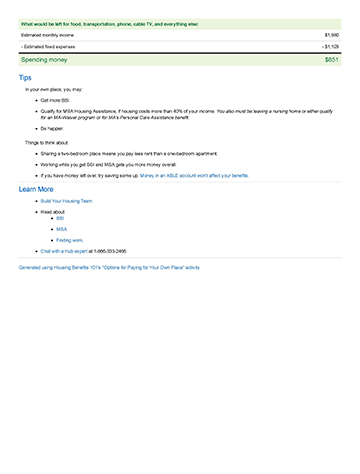Minnesota Supplemental Aid (MSA) Housing Assistance is a benefit that helps people with disabilities afford their housing. It gives an additional $483.50 per month to people on MSA who spend more than 40% of their income on housing. Every year, this amount is adjusted on July 1st, to be half of Supplemental Security Income's Federal Benefit Rate (FBR).
If you are on MSA, you should ask your county worker if you qualify for MSA Housing Assistance. There are many people on MSA who would qualify for MSA Housing Assistance if they applied.
My Vault
:
Activity
Options for Paying for Your Own Place


Do this Vault activity to Compare budget options for getting your own place.
View example
.Go To Activity
Who Can Get It
You can only get MSA Housing Assistance if you qualify for MSA. To qualify for MSA, you must both:
- Have a disability, be blind, or be age 65 or older, and
- Either get Supplemental Security Income (SSI) or not get an SSI payment only because you have countable income that is too high for SSI.
See Disability Benefits 101 for more details about MSA eligibility.
In addition to qualifying for MSA, to get MSA Housing Assistance, you must:
-
Spend more than 40% of your income on your housing expenses
- Housing expenses may include things like mortgage payments, rent, utilities (heat, gas, water, garbage, electricity, etc.), and property taxes.
- Be less than 65 years old when you apply, and
-
Be in one of these situations:
- Eligible for Medical Assistance (MA) Community First Services and Supports (CFSS)
- Living in your own home or apartment and getting services through an MA-Waiver program, or
-
Moving out of an institution, an intensive residential mental health treatment program, or a Housing Support (formerly GRH) setting and into a location in the community, such as your own home or apartment.
- For MSA, institutions can include hospitals, regional treatment centers, nursing facilities, and Intermediate Care Facilities for Persons with Developmental Disabilities (ICF/DDs).
Tip: Due to the way MSA’s rules work, some people who apply for MSA only qualify if they also apply for MSA Housing Assistance. If you get SSI benefits and your application for MSA is denied, try applying for MSA again while applying for MSA Housing Assistance at the same time.
You have to be spending more than 40% of your income for your housing to get MSA Housing Assistance. Many other programs, like Section 8, are designed to make sure you spend 40% or less of your income on housing. That means that if you get benefits from those programs, you probably don’t qualify for MSA housing assistance.
Housing Settings Where MSA May Help
MSA Housing Assistance can help you if you live in the community and not in an institution, such as a nursing home, and are paying more than 40% of your income on housing. Most people who get MSA Housing Assistance either live in their own homes or are renting a room or an apartment.
Application
You can apply for MSA and MSA Housing Assistance online using MNbenefits. You can also fill out the Combined Application Form and turn it in to your county or tribal human services office.
When you apply, you should mention MSA Housing Assistance on your application. On MNbenefits, there is a place for you to add notes. If you use the Combined Application Form, you can mention it in a blank place on the form.
More Information
Watch the below video for a quick intro to MSA Housing Assistance. HB101 also has an MSA brochure that introduces MSA and MSA Housing Assistance. For professionals: A two-hour Housing Best Practices Forum has detailed info about MSA Housing Assistance.




Give Feedback